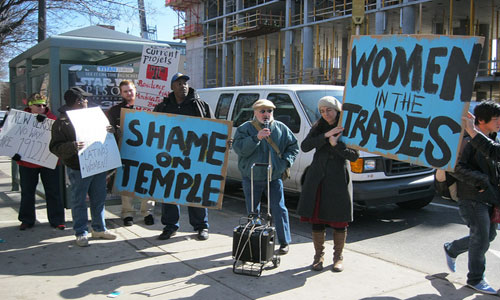
COLUMBUS, Ohio – On June 8, the Columbus Dispatch carried a poll that measured people’s opinions on issues concerning affirmative action, race, and LGBT questions. The results were generally what I would consider positive. But the affirmative action/race questions and answers were particularly revealing.
The LGBT results showed the basically positive movement in people’s opinions that all media outlets have been reporting recently. Marriage equality was supported by 52 percent, with 43 percent in opposition. Support for anti-discrimination legislation that includes gays and lesbians was higher, with 73 percent supporting it and only 22 percent stating opposition.
But where the poll got more complicated was the next section, on affirmative action.
First question: “In order to make up for past discrimination, do you favor or oppose programs that make special efforts to help blacks and other minorities get ahead?”
The responses to this question were positive and overwhelming, 68 percent in favor and only 24 percent in opposition.
The very next question was worded as follows: “Do you think black people and other minorities should receive preference in college admissions to make up for past inequalities?”
To this, similar, if not exactly the same, question, however worded much differently, the results were a surprising only 29 percent in favor and 64 percent against – basically opposite the responses to the first question.
Why? The easiest answer is that the public is overwhelmingly in favor of affirmative action favoring minorities, unless they are overwhelmingly opposed to it. However, the poll actually contains some further valuable information on this issue.
The next two questions were whether those being polled had ever been 1) personally either helped or hurt by race in college admissions, and 2) ever been personally helped or hurt in their job/career by race or ethnicity?
In answer to these two questions concerning the actual real-life experience of the folks answering the poll questions, an unbelievably tiny percentage of people reported that they’d been affected personally in any manner at all. In response to the first question, only 20 percent (10 percent helped/10 percent hurt) said they’d been affected, while on the second question, only 18 percent felt they’d been affected at all personally, with seven percent saying they’d been “helped” and 11 percent “hurt” in their job situation.
For working class and social justice activists who want to, as Karl Marx said, “Change history, not just observe it,” these answers are revealing. People have extremely strong views on race and affirmative action, but in fact say they have never noticeably been personally affected one way or another by affirmative action.
Placed another way, the poll exposes the deeply felt racial (and sometimes what could be seen as racist) views that capitalist society has driven into them; however those views in most cases have no actual connection to their own personal lives.
The wider issue is that it shows how the wording of messages, the “feeling” on an issue, regardless of real, personal experience in most cases, influences people’s opinions on real-life issues in regard to race and affirmative action. For us, I believe, the real question becomes, “What is the class perspective of those asking the question, and what result is the question actually aiming to get?”
This poll brought to mind the experience of the fight against entrenched racist corporate practices that took place, led by the rank and file movement, in the steel industry.
In 1974, a consent decree was signed by the Steelworkers Union (USWA), the major steel corporations and the U.S. government, which did the following;
* opened the craft/trade jobs to African Americans, women, Latinos, including the apprentice training programs, also setting target numbers that had to be met;
* set up a bidding system that opened all jobs to a bidding process, that allowed all workers, regardless of race, etc., to bid to leave departments where they were assigned and move to other, higher paying or more desirable areas. African American workers were given some preference, due to past discrimination, on some jobs;
* awarded monetary compensation to African American workers who’d suffered past discrimination.
This historic agreement was the result of years of tough struggle by African American steelworkers, as well as the multiracial and left-center-led rank and file movement in steel. In this fight, George Edwards, chair of the National Steelworkers Rank & File Committee and a leader of the Communist Party USA, played an extremely important role.
Almost before the ink was dry on the decree, an ultra-right assault was launched by corporate-supported, racist elements. Most prominent of those challenges was the Weber case, where a white worker at a Kaiser plant in Louisiana sued, stating that he was “better qualified” than a minority worker who was awarded a craft job, and that he should have gotten the position. (Only 1.8 percent of craft jobs were held by African American workers at the time.) This case had immediate political impact on mainly white workers across the steel industry, with racist-supported groups popping up opposing the consent decree.
George Edwards and the rank and file committee rallied the pro-consent-decree forces, calling national meetings and getting out literature supporting the decree. The key point was that he insisted that the fight be oriented on the gains that ALL workers got from the victory over racism in the decree. All workers now had the right to bid jobs and move, not only African American workers. The companies had to begin recruiting badly needed trades workers, and all could apply. Further, the victory over racism was a victory against the boss’s favoritism. It leveled the playing field for all. Within this overall context, the argument that the victory over racism also meant unity for all workers and strengthened our joint hands together, while weakening that of the corporation/boss, carried concrete meaning for those workers on the job.
It was not long before those arguments had positive impact. It is not an exaggeration at all to say that anyone coming to a Steelworkers union hall to propose ending the consent decree would be thrown out on their ear, and the arms doing it would be multi-racial! Weber lost his case in 1979 and the language of the consent decree was placed into the basic steel contract. While those gains have certainly been harmed by jobs loss and mill closures, the lessons are still very applicable.
These lessons apply to today’s battles. While we’ve won gains unless a principled independent, working class voice can carry the unifying message to regular working folks, they will continue to hear only those messages coming from ruling class sources, confusing and carrying racist poison pills. A pro-corporate, racist Supreme Court stands ready to kill key provisions of the Voting Rights Act. Social Security, Medicare, and workers’ rights to organize and be represented by unions are all under attack.
Without hearing a unifying message, working people in our nation will continue to be influenced by irrational fears, divisive messages from corporate sources. The real lesson, however, is that when regular working people see their united interest in the struggles and victories we win, they will unite and act in their own interests.
Photo: Demonstrators at Temple University in Philadelphia call on the university to make sure that the workforce on its multi-million dollar building program is diverse in both race and gender, February 2012. PW










